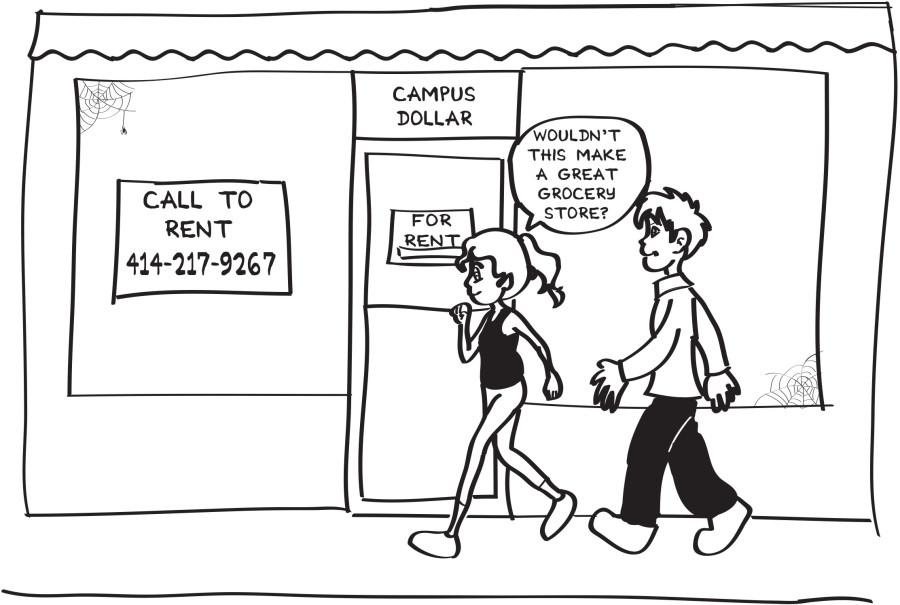The former home of Campus Dollar, 1616 W. Wisconsin Ave., sits empty, sandwiched between Cousin’s Subs and McCabe Hall. Former convenience store Kampus Foods is now a pile of rubble as the new Ivy on 14th complex is constructed. The nearest full-service grocery stores are still two to four miles off-campus.
Marquette students and their neighbors continue to live in a food desert. It’s time the university steps up to change that.
As noted in a Sept. 3 Tribune editorial, students only have two on-campus grocery options: Walgreens and 7-Eleven. Both of these are more expensive and have less selection, than off-campus stores such as Target or Pick ‘n Save, leaving students with only a few pricey possibilities to choose from.
Thus far, the university tried to work with the Avenues West Association, the Redeemer Lutheran Church and others in the community to entice a grocer to open a store in the area to no avail.
Because these larger organizations have not solved the problem, Marquette Student Government is trying to find short-term solutions. The organization is researching options such as more farmer’s markets or bus trips to grocery stores to offset student concerns about buying groceries within our food desert.
These ideas may work as short-term fixes to divert students’ attention from the problem, but they are akin to putting a Band-Aid on a head wound for the problems facing Marquette and its surrounding neighborhood.
Our census tract – the geographic city blocks the U.S. census links together to define a neighborhood – is a food desert as defined by the United States Department of Agriculture: an urban neighborhood “without ready access to fresh, healthy, and affordable food,” and only served by “fast food restaurants and convenience stores.” The tract is “low-income,” defined as an area with a poverty rate of 20 percent or higher or an area in which median family income is at or below 80 percent of the larger area’s median family income. It is also “low-access” with at least 500 persons and/or at least 33 percent of the population living more than one mile from a supermarket or large grocery store.
MUSG’s attempts are good efforts at solving the problem with the power it has. Yet it’s up to the university to spearhead the healthful food initiative. Working with community leaders such as the Avenues West Association to fix the food desert is a good starting point. But the fact is, there have been six on-campus construction projects this year alone, and none of them address the lack of food options.
Business leaders cite several issues in attracting supermarkets to the area. The largest issue seems to be profitability and demand serving a small non-student population. Estimates of profitability do not include temporary student residents in neighborhood population counts.
Profitability is a genuine, important concern for any business in the area. This issue plagues urban areas across the United States, especially food deserts in which there are a combination of low access and low income. Businesses don’t wish to establish branches in areas that could pose financial risks, especially one with a large portion of customers leaving from May to August.
The university should step in to assuage concerns about profitability. A possible plan would be offering subsidized rent to a supermarket for the empty, university-owned Campus Dollar space.
While subsidizing rent may not seem like a good idea financially, it would be more lucrative for the university than leaving the space vacant.
If Marquette is serious about working to get a grocery store in the neighborhood, the empty 4,000 square feet would be a good place to start. If the university would be willing to subsidize rent initially to attract grocery tenants to the space, profitability concerns may lessen.
Oakland, Calif. is attempting a similar scheme in the historic Old Oakland district that saw success in attracting tenants. While Oakland’s version offered free rent for a short amount of time, it is successful in creating larger profit margins and attracting businesses and customers to the area.
A reduction in rent would not require such high revenue rates for the occupant to turn a profit. Subsidized rent would make the space more attractive to buyers, and subsidized rent for grocers would ensure the university helps bring in the healthy food options our neighborhood needs.

